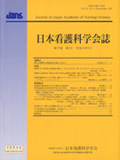Japanese
English
- 販売していません
- Abstract 文献概要
- 参考文献 Reference
要旨
【目的】看護学生の表情認知を看護師と比較しその特徴を把握するとともに,表情認知と情動的共感性との関連について明らかにする.
【方法】A大学の看護学生63名,B病院の看護師45名を対象とした.表情認知の測定にはJIFPテストを用い,対象者が回答した感情・情緒を該当するカテゴリーに分類し,各写真のカテゴリー別出現率およびカテゴリー使用頻度を求めた.また写真が示す快-不快感情の評定を5段階評価した.情動的共感性の測定には,情動的共感性尺度を用いた.
【結果】1.看護学生,看護師ともに対象者の表情を良く認知していたが,一部の表情では認知に差異が認められた.2.カテゴリー使用頻度は学生では悲哀,不満,嫉妬,その他が高く,看護師では眠気,自己主張が高かった.3.学生,看護師ともに快-不快評定では適切に評価していたが,12枚の写真で差が認められ主に学生の得点が低かった.4.情動的共感性の尺度Ⅰ(感情的暖かさ)は学生の得点が,尺度Ⅱ(感情的冷淡さ)は看護師の得点が有意に高かった.5.情動的共感性の各尺度と一部のカテゴリー使用頻度とは相関が認められた.
【考察】看護学生の表情認知に差異が認められた要因として,情動的共感性が関与していることが示唆された.
Abstract
Purpose: The purpose of this study was to clarify the cognition of facial expression between the nursing students and the nurses, and the relationship between the cognition of facial expression and that of emotional sympathy.
Method: The participants were 63 nursing students of “A” University, and 45 nurses of “B” hospital. JIFP test was used for measurement of the cognition of facial expression. The feeling and the emotion which was answered by the participants were classified into the corresponding categories, and the appearance rate of the category of each photograph and the frequency of the use of the category were calculated. Moreover, pleasant-unpleasant feelings of photographs were evaluated by the participants at five point levels. The emotional sympathy scale was used for measurement of the participants' emotional sympathy.
Results: 1. Although the nursing students and the nurses recognized the photographs' expressions well, differences in the cognition were shown in some photographs. 2. The frequency of the use of sadness, dissatisfaction, jealousy, and some others was higher in the nursing students, and that of sleepiness and self-assertion was higher in the nurses. 3. Although the nursing students and the nurses evaluated the photographs' expressions appropriately on a pleasant-unpleasant feeling scale, differences were recognized with 12 photographs, and the score of the nursing students was lower than that of the nurses. 4. The score of “emotional sympathy scale I; emotional-warmth” was significantly higher in the students, but the score of “emotional sympathy scale II; emotional-coolness” was significantly higher in the nurses. 5. The correlation was recognized between the score of each of the emotional scales and the frequency of the use of some categories.
Conclusion: It was suggested that emotional sympathy was involved in cognition of the facial expressions which showed differences between the nursing students and the nurses.
Copyright © 2007, Japan Academy of Nursing Science. All rights reserved.


